Gravity-Driven Membrane Reactor for Decentralized Wastewater Treatment: Effect of Reactor Configuration and Cleaning Protocol
Abstract
1. Introduction
2. Materials and Methods
2.1. Experimental Setup and Operation Conditions
2.2. Membrane Flux Measurement and Resistance Analysis
2.3. Analytical Methods
2.4. Cost Estimation
3. Results and Discussion
3.1. Reactor Performance
3.2. Membrane Performance
3.3. Cost Estimation
4. Conclusions
Author Contributions
Funding
Institutional Review Board Statement
Informed Consent Statement
Data Availability Statement
Acknowledgments
Conflicts of Interest
References
- Jones, E.R.; van Vliet, M.T.H.; Qadir, M.; Bierkens, M.F.P. Country-level and gridded estimates of wastewater production, collection, treatment and reuse. Earth Syst. Sci. Data 2021, 13, 237–254. [Google Scholar]
- The United Nations. Available online: https://www.un.org/sustainabledevelopment/water-and-sanitation/ (accessed on 26 February 2021).
- Hube, S.; Wang, J.W.; Sim, L.N.; Chong, T.H.; Wu, B. Direct membrane filtration of municipal wastewater: Linking periodical physical cleaning with fouling mechanisms. Sep. Purif. Technol. 2021, 259, 118125. [Google Scholar]
- Zhou, H.X.; Li, X.; Xu, G.R.; Yu, H.R. Overview of strategies for enhanced treatment of municipal/domestic wastewater at low temperature. Sci. Total Environ. 2018, 643, 225–237. [Google Scholar] [CrossRef] [PubMed]
- Fortunato, L.; Ranieri, L.; Naddeo, V.; Leiknes, T. Fouling control in a gravity-driven membrane (GDM) bioreactor treating primary wastewater by using relaxation and/or air scouring. J. Membr. Sci. 2020, 610, 118261. [Google Scholar] [CrossRef]
- Lee, S.; Badoux, G.O.; Wu, B.; Chong, T.H. Enhancing performance of biocarriers facilitated gravity-driven membrane (GDM) reactor for decentralized wastewater treatment: Effect of internal recirculation and membrane packing density. Sci. Total Environ. 2021, 762, 144104. [Google Scholar] [CrossRef]
- Lee, S.; Sutter, M.; Burkhardt, M.; Wu, B.; Chong, T.H. Biocarriers facilitated gravity-driven membrane (GDM) reactor for wastewater reclamation: Effect of intermittent aeration cycle. Sci. Total Environ. 2019, 694, 133719. [Google Scholar] [CrossRef] [PubMed]
- Jin, X.; Wang, W.; Wang, S.; Jin, P.K.; Wang, X.C.C.; Zhang, W.S.; An, W.J.; Wang, Y. Application of a hybrid gravity-driven membrane filtration and dissolved ozone flotation (MDOF) process for wastewater reclamation and membrane fouling mitigation. J. Environ. Sci. 2019, 81, 17–27. [Google Scholar] [CrossRef] [PubMed]
- Wang, Y.R.; Fortunato, L.; Jeong, S.; Leiknes, T. Gravity-Driven membrane system for secondary wastewater effluent treatment: Filtration performance and fouling characterization. Sep. Purif. Technol. 2017, 184, 26–33. [Google Scholar] [CrossRef]
- Pronk, W.; Ding, A.; Morgenroth, E.; Derlon, N.; Desmond, P.; Burkhardt, M.; Wu, B.; Fane, A.G. Gravity-Driven membrane filtration for water and wastewater treatment: A review. Water Res. 2019, 149, 553–565. [Google Scholar] [CrossRef] [PubMed]
- Peter-Varbanets, M.; Hammes, F.; Vital, M.; Pronk, W. Stabilization of flux during dead-end ultra-low pressure ultrafiltration. Water Res. 2010, 44, 3607–3616. [Google Scholar] [CrossRef]
- Ding, A.; Wang, J.L.; Lin, D.C.; Tang, X.B.; Cheng, X.X.; Li, G.B.; Ren, N.Q.; Liang, H. In situ coagulation versus pre-coagulation for gravity-driven membrane bioreactor during decentralized sewage treatment: Permeability stabilization, fouling layer formation and biological activity. Water Res 2017, 126, 197–207. [Google Scholar] [CrossRef] [PubMed]
- Derlon, N.; Koch, N.; Eugster, B.; Posch, T.; Pernthaler, J.; Pronk, W.; Morgenroth, E. Activity of metazoa governs biofilm structure formation and enhances permeate flux during Gravity-Driven Membrane (GDM) filtration. Water Res. 2013, 47, 2085–2095. [Google Scholar] [CrossRef] [PubMed]
- Akhondi, E.; Wu, B.; Sun, S.Y.; Marxer, B.; Lim, W.K.; Gu, J.; Liu, L.B.; Burkhardt, M.; McDougald, D.; Pronk, W.; et al. Gravity-driven membrane filtration as pretreatment for seawater reverse osmosis: Linking biofouling layer morphology with flux stabilization. Water Res. 2015, 70, 158–173. [Google Scholar] [CrossRef]
- U.S. EPA. Membrane Filtration Guidance Manual; United States Environmental Protection Agency, Office of Water: Washington, DC, USA, 2005. [Google Scholar]
- Truttmann, L.; Su, Y.; Lee, S.; Burkhardt, M.; Brynjólfsson, S.; Chong, T.H.; Wu, B. Gravity-driven membrane (GDM) filtration of algae-polluted surface water. J. Water Process. Eng. 2020, 36, 101257. [Google Scholar] [CrossRef]
- Wu, B.; Christen, T.; Tan, H.S.; Hochstrasser, F.; Suwarno, S.R.; Liu, X.; Chong, T.H.; Burkhardt, M.; Pronk, W.; Fane, A.G. Improved performance of gravity-driven membrane filtration for seawater pretreatment: Implications of membrane module configuration. Water Res. 2017, 114, 59–68. [Google Scholar] [CrossRef] [PubMed]
- APHA. Standard Methods for the Examination of Water and Wastewater, 20th ed.; American Public Health Association: Washington, DC, USA, 1998. [Google Scholar]
- Áhugaverðar Tölulegar Upplýsingar um Fráveituna. Available online: https://www.veitur.is/fraveitan-i-tolum (accessed on 25 March 2021).
- Mulder, M. Basic Principles of Membrane Technology, 2nd ed.; Kluwer Academic Publishers: Dordrecht, The Netherlands, 1997. [Google Scholar]
- Verrecht, B.; Maere, T.; Nopens, I.; Brepols, C.; Judd, S. The cost of a large-scale hollow fibre MBR. Water Res. 2010, 44, 5274–5283. [Google Scholar] [CrossRef]
- Fletcher, H.; Mackley, T.; Judd, S. The cost of a package plant membrane bioreactor. Water Res. 2007, 41, 2627–2635. [Google Scholar] [CrossRef]
- Lin, H.; Chen, J.; Wang, F.; Ding, L.; Hong, H. Feasibility evaluation of submerged anaerobic membrane bioreactor for municipal secondary wastewater treatment. Desalination 2011, 280, 120–126. [Google Scholar] [CrossRef]
- Maere, T.; Verrecht, B.; Moerenhout, S.; Judd, S.; Nopens, I. BSM-MBR: A benchmark simulation model to compare control and operational strategies for membrane bioreactors. Water Res. 2011, 45, 2181–2190. [Google Scholar] [CrossRef]
- Tay, M.F.; Liu, C.; Cornelissen, E.R.; Wu, B.; Chong, T.H. The feasibility of nanofiltration membrane bioreactor (NF-MBR) plus reverse osmosis (RO) process for water reclamation: Comparison with ultrafiltration membrane bioreactor (UF-MBR) plus RO process. Water Res. 2018, 129, 180–189. [Google Scholar] [CrossRef]
- Elbana, M.; de Cartagena, F.R.; Puig-Bargues, J. Effectiveness of sand media filters for removing turbidity and recovering dissolved oxygen from a reclaimed effluent used for micro-irrigation. Agric. Water Manag. 2012, 111, 27–33. [Google Scholar] [CrossRef]
- Lee, S.; Suwarno, S.R.; Quek, B.W.H.; Kim, L.; Wu, B.; Chong, T.H. A comparison of gravity-driven membrane (GDM) reactor and biofiltration plus GDM reactor for seawater reverse osmosis desalination pretreatment. Water Res. 2019, 154, 72–83. [Google Scholar] [CrossRef]
- The European Commission. Directive 91/271/EEC on Urban Waste Water Treatment. Off. J. Eur. Communities 1991, 135, 40–52. [Google Scholar]
- Meng, S.; Meng, X.; Fan, W.; Liang, D.; Wang, L.; Zhang, W.; Liu, Y. The role of transparent exopolymer particles (TEP) in membrane fouling: A critical review. Water Res. 2020, 181, 115930. [Google Scholar] [CrossRef]
- Chang, H.Q.; Liu, B.C.; Wang, H.Z.; Zhang, S.Y.; Chen, S.; Tiraferri, A.; Tang, Y.Q. Evaluating the performance of gravity-driven membrane filtration as desalination pretreatment of shale gas flowback and produced water. J. Membrane Sci. 2019, 587, 117187. [Google Scholar] [CrossRef]
- Farhat, N.M.; Vrouwenvelder, J.S.; Van Loosdrecht, M.C.M.; Bucs, S.S.; Staal, M. Effect of water temperature on biofouling development in reverse osmosis membrane systems. Water Res. 2016, 103, 149–159. [Google Scholar] [CrossRef]
- Ma, Z.; Wen, X.; Zhao, F.; Xia, Y.; Huang, X.; Waite, D.; Guan, J. Effect of temperature variation on membrane fouling and microbial community structure in membrane bioreactor. Bioresour. Technol. 2013, 133, 462–468. [Google Scholar] [CrossRef]
- Kelly, L.C.; Cockell, C.S.; Piceno, Y.M.; Andersen, G.L.; Thorsteinsson, T.; Marteinsson, V. Bacterial Diversity of Weathered Terrestrial Icelandic Volcanic Glasses. Microb. Ecol. 2010, 60, 740–752. [Google Scholar] [CrossRef] [PubMed]
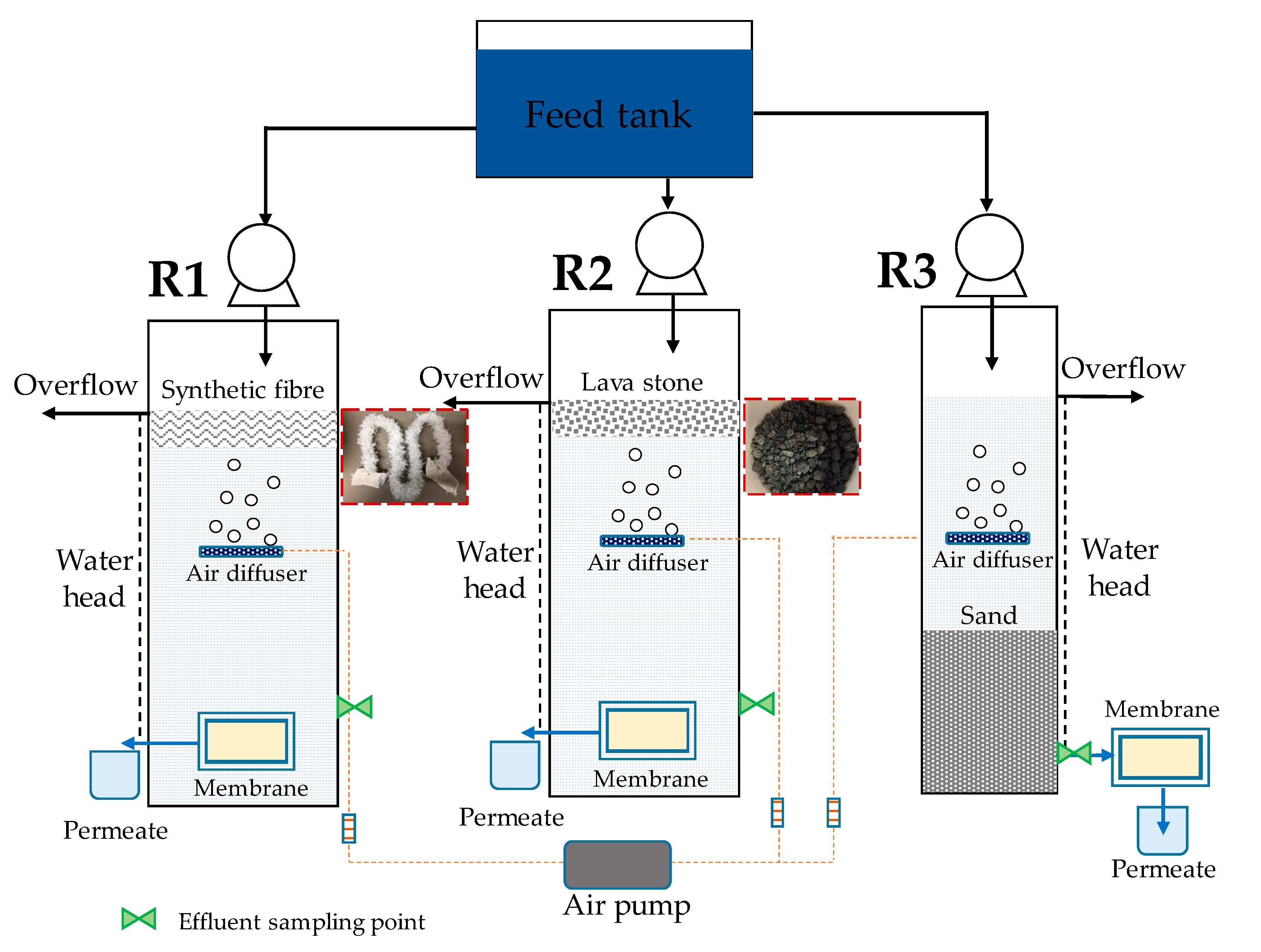
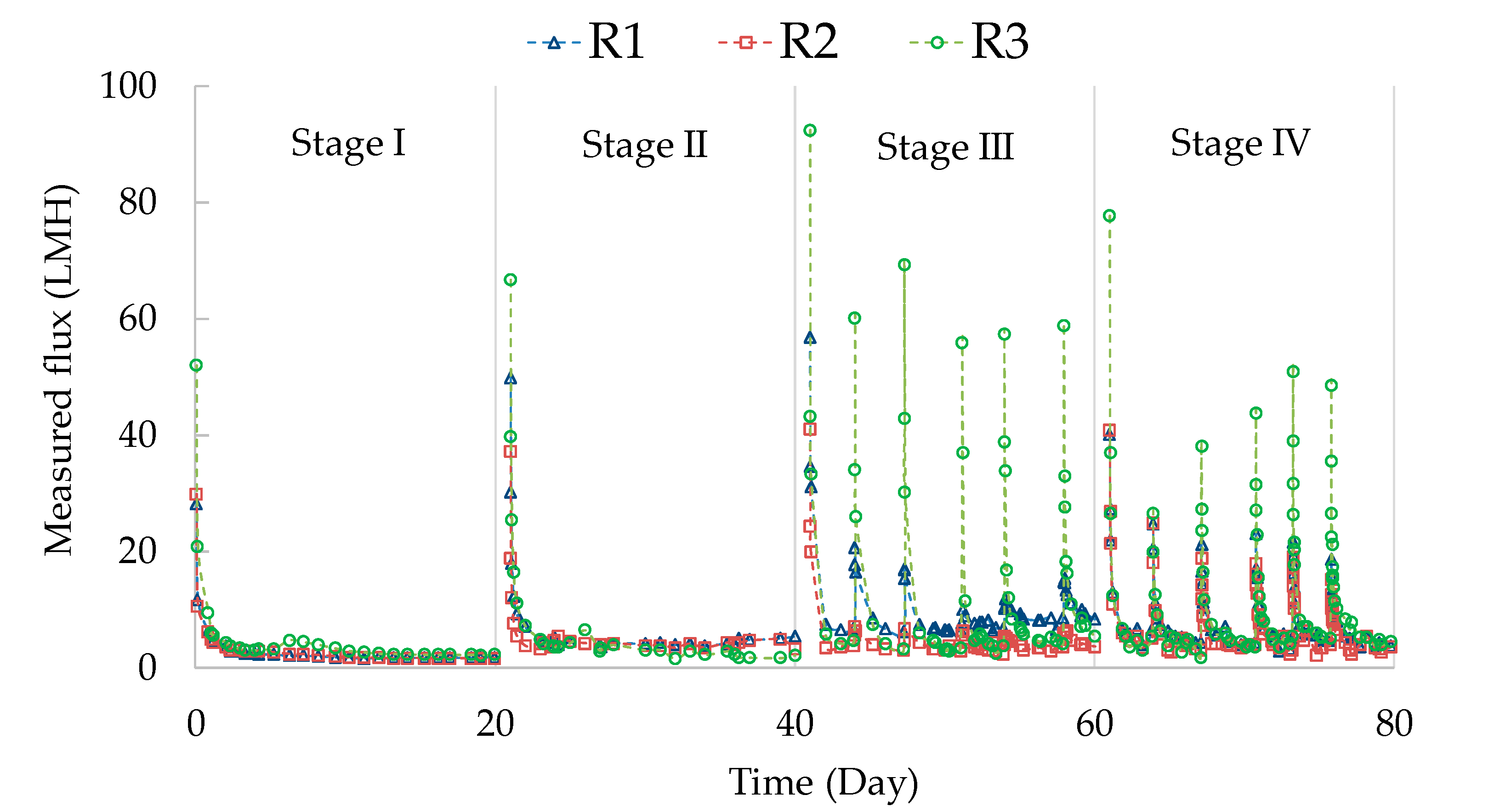

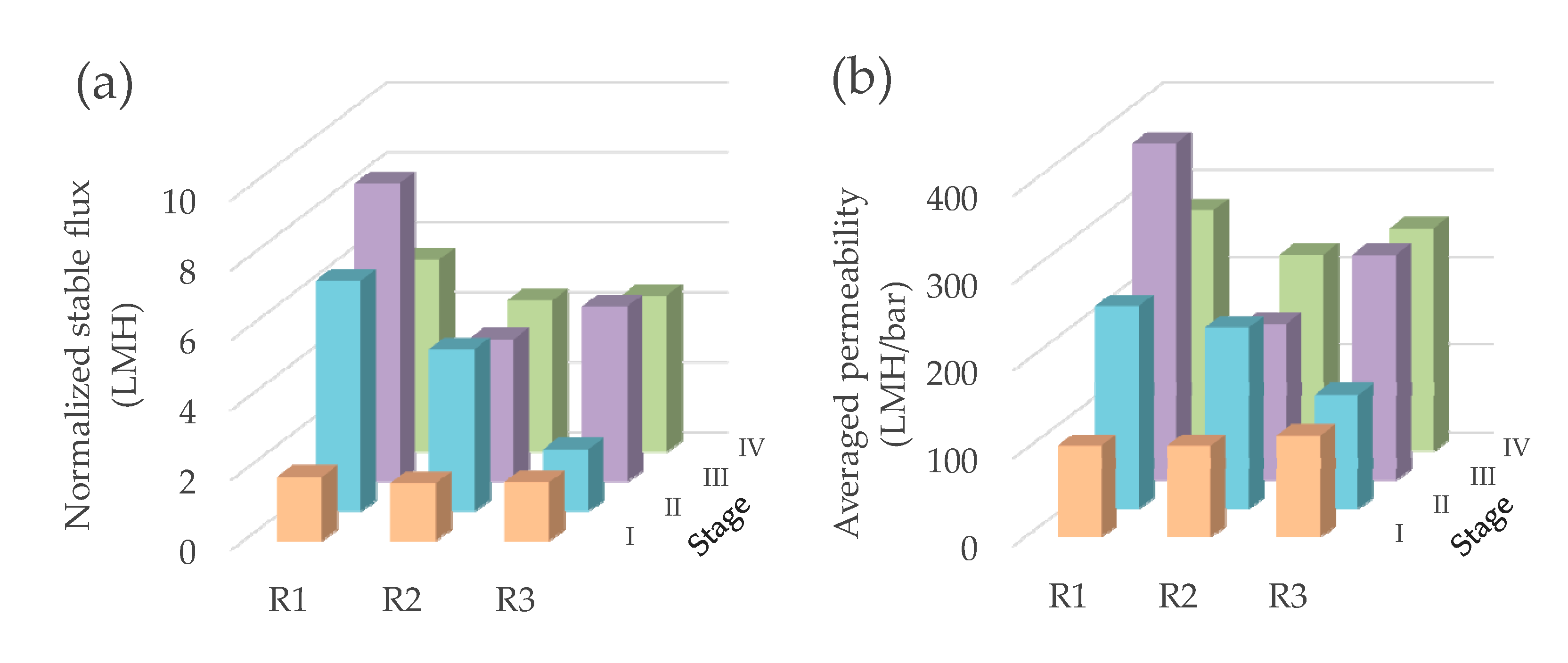
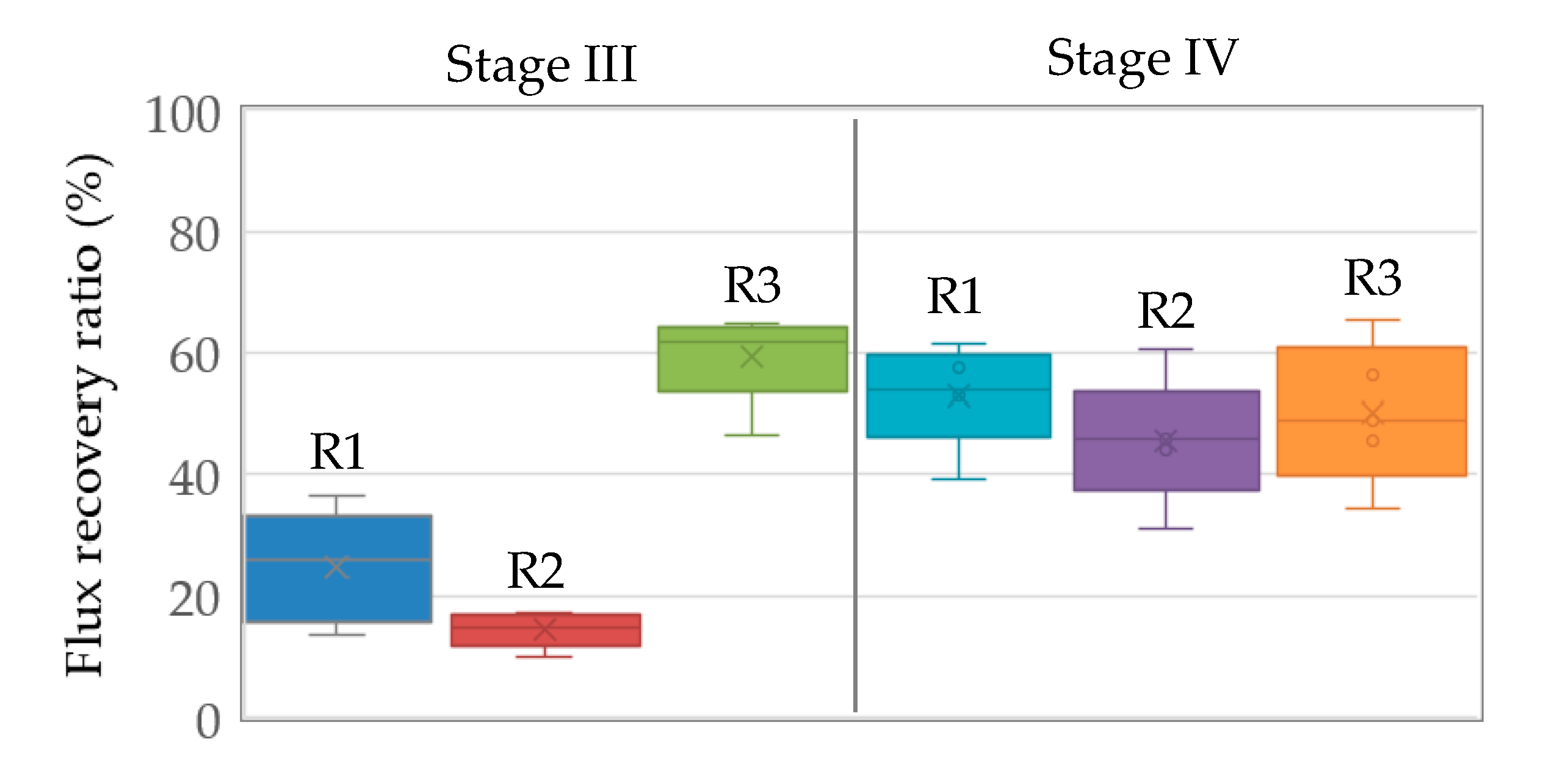
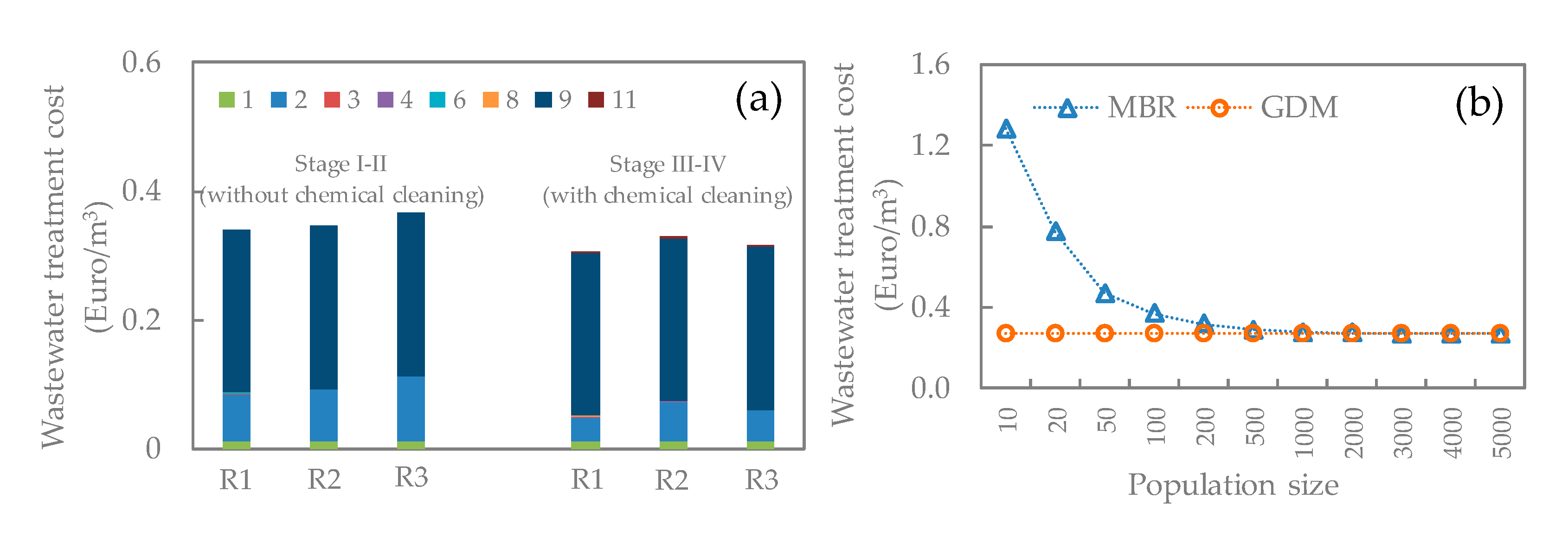
| Stage | Operation Parameters | R1 | R2 | R3 |
|---|---|---|---|---|
| Stage I (day 0–20) | Condition | Operated at ~22 °C and no cleaning | ||
| Constant water head | 0.25 m | 0.25 m | 0.34 m | |
| Stage II (day 21–40) | Condition | Operated at ~22 °C and no cleaning | ||
| Variable water head | 0.19–0.25 m | 0.19–0.25 m | 0.23–0.34 m | |
| Stage III (day 41–60) | Condition | Operated at ~22 °C and periodical chemical cleaning (30 min per 3–4 days) | ||
| Variable water head | 0.21–0.25 m | 0.21–0.25 m | 0.24–0.34 m | |
| Stage IV (day 61–80) | Condition | Operated at ~10 °C and periodical chemical cleaning (60 min per 3–4 days) | ||
| Variable water head | 0.22–0.25 m | 0.22–0.25 m | 0.24–0.34 m | |
| Capital Cost Item | Details |
|---|---|
| (1) Reactor tank (GDM, MBR) | Feed flow*HRT*1.1*220 EUR/m3 (1.1 is a factor considering biocarrier volume and submerged membrane volume based on the lab-scale biocarrier packing situation and flat sheet membrane packing density at 360 m2/m3 [20]; tank price was assumed to be 220 EUR/m3) |
| (2) Membrane (GDM, MBR) | ((Feed flow)/(permeate flux)) * 50 EUR/m2 (For GDM, permeate flux = averaged permeability*water head at 0.25 m; for MBR, permeate flux was set at 20 LMH; MF membrane price was assumed to be 50 EUR/m2 [21]) |
| (3) Feed pump (GDM, MBR)/permeate pump (MBR) | Feed flow*20 EUR/m3/h [22] |
| (4) Air blower (for biological) (GDM, MBR) | Feed flow*75 EUR/m3/h [22] |
| (5) Air blower (for membrane in MBR) | Feed flow*80 EUR/m3/h [22] |
| (6) Biocarriers (GDM) | Reactor volume*packing ratio* biocarrier cost (Packing ratio was estimated based on the lab setup and biocarrier cost was estimated at 0.255 EUR/m for synthetic fiber, 20 and 52 EUR/ton for lava stone and sands) |
| (7) PLC control system (MBR) | (20,000 + feed flow*10) EUR [23] |
| Operational Cost Item | Details |
| (8) Feed pump energy cost (GDM, MBR)/permeate pump (MBR) | ((Water head*feed flow*365/(36*pump efficiency))*0.134 EUR/kWh (Pump efficiency is assumed at 80%; for GDM, the feed pump water heat at 25 cm (i.e., 0.023 bar); for MBR permeate pump, pressure (water head) at 0.2 bar; electricity cost in Iceland was at 0.134 EUR/kWh) |
| (9) Air blower energy cost (for biological) (GDM, MBR) | Aeration rate * 0.025 kWh/m3 air * 0.134 EUR/kWh [24] |
| (10) Air blower energy cost (for membrane in MBR) | Membrane area * 0.019 kWh/m3 air * 0.3 m3 air/m2h *0.134 EUR/kWh [24,25] |
| (11) Chemical cost (GDM, MBR) | 0.024 L/m2/time* membrane area* 60 EUR/m3 *100 time/year |
| (12) Sludge treatment (MBR) | Biomass (5 g/L) * reactor volume* 150 EUR/ton dry mass (SRT at 20 days) [21] |
| Parameter | Feed Water | R1 | R2 | R3 | |||
|---|---|---|---|---|---|---|---|
| Reactor (Effluent) | Permeate | Reactor (Effluent) | Permeate | Reactor (Effluent) | Permeate | ||
| DO in aeration zone (mg/L) (n = 27) | - | 8.0 ± 1.1 (7.1, 8.9) 1 | - | 8.2 ± 0.9 (7.8, 9.0) | - | 7.6 ± 0.6 (6.1, 8.3) | - |
| pH (n = 28) | 7.8 ± 0.4 (6.8, 8.6) | 8.2 ± 0.4 (6.9, 8.9) | 8.8 ± 0.5 (7.8, 9.4) | 8.1 ± 0.4 (6.8, 8.7) | 8.7 ± 0.4 (7.8, 9.3) | 8.1 ± 0.4 (7, 8.8) | 8.6 ± 0.3 (7.7, 9.1) |
| Conductivity (μS/cm) (n = 28) | 1231 ± 373 (955, 1893) | 1193 ± 299 (932, 1842) | 1196 ± 289 (887, 1830) | 1213 ± 311 (938, 1877) | 1209 ± 302 (868, 1851) | 1231 ± 389 (964, 1941) | 1235 ± 357 (992, 1967) |
| Turbidity (NTU) (n = 28) | 35.8 ± 20.3 (2.7, 76.3) | 8.3 ± 6.9 (0.6, 20.2) | 0.1 ± 0.2 (0, 0.8) | 11.1 ± 10 (0.7, 50.5) | 0.1 ± 0.1 (0, 0.5) | 7.0 ± 5.5 (1.3, 19.3) | 0.1 ± 0.2 (0, 0.5) |
| TSS (mg/L) (n = 4) | 17.5 ± 7.2 (11, 26) | 5.0 ± 2.9 (2, 8) | ND 2 | 7.8 ± 8.3 (1, 18) | ND | 2.5 ± 2.4 (1, 6) | ND |
| BOD5 (mg/L) (n = 10) | 67.4 ± 27.3 (10, 109) | 22.4 ± 10.7 (10.2, 40.2) | 2.9 ± 1.8 (0.3, 6.3) | 26.5 ± 9.8 (4, 41) | 2.1 ± 1.5 (0.6, 5.5) | 27.3 ± 11.7 (4, 41) | 2.2 ± 1.3 (0.6, 5.5) |
| COD (mg/L) (n = 4) | 110.5 ± 17.9 (90.7, 134) | 22.1 ± 6.3 (13, 26.3) | 20.2 ± 4.1 (16.5, 24.5) | 27.1 ± 2.9 (24.5, 31.1) | 19.7 ± 1.5 (18.3, 21.2) | 30.1 ± 6.4 (24, 37.5) | 24.6 ± 8.5 (17.6, 36.5) |
| TN (mg/L) (n = 4) | 25.1 ± 1.4 (23.5, 26.8) | 24 ± 1 (22.5, 24.9) | 19.5 ± 1 (18.2, 20.6) | 23.9 ± 0.5 (23.4, 24.4) | 19.2 ± 1.2 (17.7, 20.3) | 19.6 ± 2.8 (15.7, 22.4) | 15.8 ± 2 (14.5, 18.7) |
Publisher’s Note: MDPI stays neutral with regard to jurisdictional claims in published maps and institutional affiliations. |
© 2021 by the authors. Licensee MDPI, Basel, Switzerland. This article is an open access article distributed under the terms and conditions of the Creative Commons Attribution (CC BY) license (https://creativecommons.org/licenses/by/4.0/).
Share and Cite
Shami, I.U.H.; Wu, B. Gravity-Driven Membrane Reactor for Decentralized Wastewater Treatment: Effect of Reactor Configuration and Cleaning Protocol. Membranes 2021, 11, 388. https://doi.org/10.3390/membranes11060388
Shami IUH, Wu B. Gravity-Driven Membrane Reactor for Decentralized Wastewater Treatment: Effect of Reactor Configuration and Cleaning Protocol. Membranes. 2021; 11(6):388. https://doi.org/10.3390/membranes11060388
Chicago/Turabian StyleShami, Ihtisham Ul Haq, and Bing Wu. 2021. "Gravity-Driven Membrane Reactor for Decentralized Wastewater Treatment: Effect of Reactor Configuration and Cleaning Protocol" Membranes 11, no. 6: 388. https://doi.org/10.3390/membranes11060388
APA StyleShami, I. U. H., & Wu, B. (2021). Gravity-Driven Membrane Reactor for Decentralized Wastewater Treatment: Effect of Reactor Configuration and Cleaning Protocol. Membranes, 11(6), 388. https://doi.org/10.3390/membranes11060388







